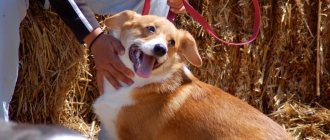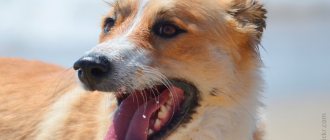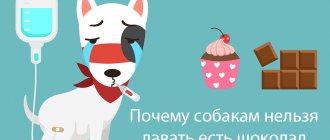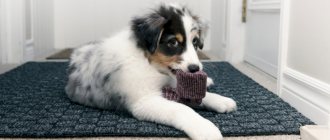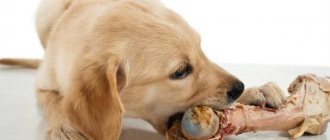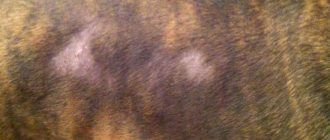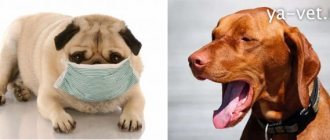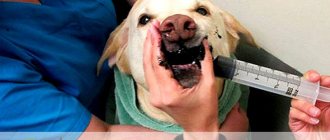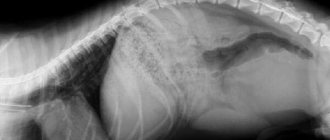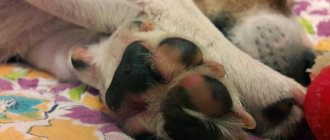Dogs love to chew on bones, but the sharp edges and pieces can be harmful to their digestive system. If your pet shows lethargy, coughs, refuses to eat, trembles its stomach and body, and blood is visible during bowel movements, these may be signs of damage to the intestinal walls and other organs of the digestive tract from bone fragments.
When a dog has eaten a bone and later shows signs of ill health, it should be given first aid at home and then taken to the veterinarian.
The dog ate a chicken bone
Chicken bones from young broilers are not dangerous for dogs. They can be given boiled or raw. They are easily chewed and are malleable to healthy dog teeth. If your dog eats a chicken bone from a supermarket bird, there is no need to worry.
Chicken bones from village laying hens that have been raised for more than a year are much worse for your pet’s health. Poultry bones are hard and strong; when broken, they have dangerous sharp edges that can cut the dog’s intestines or stomach, pierce the walls of organs, cause internal bleeding and death of the animal. At the first symptoms of damage to internal organs, the dog should be taken to the veterinary clinic for an x-ray.
When to contact a veterinarian
Many dog owners don’t know what to do if their dog eats a whole chicken bone and are at a loss. But this should not be allowed, because the owner’s main task is to find his way in time.
Indeed, there are cases when the bone has not passed far and you can pull it out yourself. You should not hope that the foreign body will be digested and come out naturally during your next trip to the toilet. The chances of such an outcome are extremely small, and by letting the situation take its course, the owner is putting the pet’s life in danger.
For your information! If the owner understands that he is not able to help the pet on his own, it is necessary to urgently go to the veterinarian. The clinic will definitely help the dog and do it under anesthesia, so that the pet will not feel pain, discomfort or fear.
You can’t put off going to the vet for too long, because when a foreign body enters the body, it’s not even hours that count, but minutes.
Another task of the owner is to carefully transport the dog to the clinic. If the swallowed bone does not immediately damage the internal organs, it may do so during sudden or careless movements of the animal.
The dog ate a fish bone
Fish bones are very thin and sharp. They are not visible on x-rays and can only be detected by an experienced specialist. On the one hand, fish bones are not very dangerous for the pet’s life. They do not block the airways and do not lead to suffocation. However, when pierced, the needle-like bones cause unbearable pain, the dog begins to whine, suffer from insomnia, and refuse water and food.
If your dog has eaten a fish bone and it is stuck in the larynx, you can remove it with tweezers. To do this, one person fixes the mouth in an open position, the other, armed with tweezers sterilized with alcohol, must pick up, securely clamp the tip of the bone and pull it out of the larynx in one confident movement.
Consequences
Owners of pets who like to swallow everything should be on alert. But there is not always cause for concern.
There are cases that the bone, even swallowed whole, was generally small in size. If we are not talking about a puppy (whose digestion is still weak and not yet formed), but about an adult dog that does not have problems with the gastrointestinal tract, then there is a possibility that the bone will be digested and leave the animal’s body naturally.
Letting the situation take its course, you need to carefully monitor the animal’s well-being. If for several days the dog remains active, playful, and has a healthy appetite, then there is no reason to worry.
Important! A small, irregularly shaped bone can become lodged in the throat and cause choking, so contact your veterinarian immediately.
When a bone is clogged in the intestines and does not come out on its own, it is also necessary to contact a veterinarian, because this can result in the death of the animal.
The dog ate a tubular bone
Veterinarians strongly advise against giving adult dogs and puppies tubular bones. They can simply be swallowed whole or chewed into small pieces with sharp edges. In both cases, harm is caused to the health of the pet.
What dangers can await if a dog has eaten a tubular bone:
- Infection from chicken, rabbit, beef or pork bones, if the killed animal suffered from infectious diseases. Even high cooking temperatures do not destroy some types of bacteria in the bones.
- Damage to the fragile enamel of the baby teeth of puppies, and grinding down of the molars of adult dogs. The sharp edges of the tubular bone often damage the gums.
- Bones and their fragments are not digested by the gastrointestinal tract of dogs, but are compressed into dense masses. This causes constipation and gas formation.
- A dog can choke on sharp fragments. Bone particles can injure the esophagus, stomach, intestines, cut the walls of organs, and cause peritonitis.
What are the forecasts
Often, owners do not know what to do if the dog has eaten chicken bones, and for some reason they decide not to do anything. This should not be allowed under any circumstances, because inaction on the part of the owner can cost his pet his life.
External symptoms - vomiting, lethargic appearance
When a tubular chicken bone enters a dog's body, its sharp edges damage the walls of the organs. This leads to inflammation of the affected area and the appearance of free gas inside the body. The damaged organ wall no longer protects the stomach or intestines from harmful bacteria, so they easily penetrate inside and cause a bacterial infection. This leads to the death of the pet.
However, it is not only sharp bones that pose a danger (such as chicken or fish bones without meat). Even soft shaped pits, such as mango or plum pits, can be deadly. They do not directly damage the walls of internal organs, but lead to blockage of blood vessels and compress tissue. Eventually the damaged tissue dies (necrosis occurs) and a tear still forms.
Swallowed it without choking
In this case, you must prevent the moment when the bone can cut the walls of the stomach. You need to act immediately, without delay. You don't have to wait until your dog goes to the toilet to check his stool. You must be proactive.
Experienced dog breeders recommend giving your dog a piece of wax candle right away. The size should be something that the dog can easily swallow. You can give up to three times a day. The wax quickly begins to melt in the body and envelops the walls of the esophagus and the bone itself.
Then all you have to do is monitor her condition. If it worsens, consult a doctor immediately. There are some things you definitely shouldn't do:
- Do not induce vomiting in your dog. Otherwise, spasms can only make things worse. The bone will scratch the walls of the stomach.
- Avoid the laxative idea for the same reason.
What to do if you choked?
The first thing to do is to calm down yourself and not panic. Calmly examine the animal and understand how big the problem is. If you see that your dog’s tongue has turned blue and he is having difficulty breathing, then you need urgent help from a specialist.
Attention! You cannot pour anything down an animal’s throat; its swallowing reflex may be impaired, and it will simply choke.
If contacting a specialist is not possible, then proceed to help yourself. Please note that the activities for large and small dog breeds are different.
Algorithm of action to help small breeds:
- Place the animal on your lap.
- Press it to your chest.
- Place the fist of one hand in the place where the chest area meets the stomach.
- Support your head with your left hand.
- Squeeze the animal, moving the pressure upward.
Algorithm of actions to help large breeds:
- Stand behind the dog.
- Wrap your arms around her under her ribcage.
- Place the fist of your right hand under the sternum.
- With your left hand, grab your torso and grab the elbow of your right hand.
- Start squeezing.
Usually about 4-6 times are enough, and the dog is freed from the bone. But if this does not happen, then urgently call a specialist.
If you see that the bone is at the very beginning of the esophagus, you can remove it manually. To do this, you need to open the dog's mouth and press the tongue well with a spoon. Using tweezers, carefully pull out the bone. The main thing is not to push it further.
If you manage to remove it, watch the animal. If blood appears in the saliva, promptly take your pet to the veterinarian.
With this they read:
Food allergies in dogs: signs and treatment
Food allergy is a hypersensitivity reaction to a component of the diet, most often to protein. Accompanied by skin rash, itching and pathological changes in internal organs.
Diarrhea in cats, treatment and causes
Diarrhea (diarrhea in cats) is a fairly common occurrence, which is usually associated with a violation of the rules of keeping the animal and can be accompanied by frequent, often painful, loose stools for quite a long time.
Mammary tumors in dogs: treatment and removal surgery
Mammary tumors are a common diagnosis in dogs, especially older ones. This pathology is in second place in terms of prevalence after skin neoplasms. Females are predisposed to the development of the disease; very rarely, mammary tumors are diagnosed in males, mainly with pathologies of the endocrine system.
Symptoms
There are cases when the owner lost sight of the animal, did not keep track, it climbed into the trash can and ate bones. Kind guests can also treat their pet from the table without thinking about the consequences. How can you tell if an animal has eaten bones? You can determine this by its state:
- lack of appetite;
- lethargic state;
- discomfort, anxiety;
- pitiful whining;
- cough;
- excessive salivation;
- vomit;
- constipation;
- blood in stool;
- bleeding.
Complications can vary in severity. But in any case, the dog should be shown to a doctor.
Consequences of the animal's condition from eating bones:
- The animal can injure the throat. And not just scratch the mucous membrane, but also pierce it with a sharp bone. If this happens in the area of the vocal cords, where there are many vessels, bleeding may begin.
- If a pet swallows a bone, it can damage the trachea. It is very dangerous. If the veterinary clinic is far from you, then you will not have time to save him. He will bleed to death or choke on blood.
- Suffocation. The bone gets stuck in the teeth, and the dog may choke on its own saliva. We need urgent and timely help.
- When a bone is swallowed, it gets stuck in the stomach. For this reason, the dog begins to vomit. There is a risk of death from dehydration. Since the bone does not leave the body along with vomiting. This problem can only be solved surgically.
- Accumulation of bones. In this case, small bones clog the stomach and do not move further down the esophagus. A dog's metabolism becomes disrupted over time. The animal may die either from bleeding or from obstruction.
- Perforation of the small intestine. This also leads, like most of the described cases, to bleeding. The animal urgently needs surgery and a long recovery after it.
- Blockage of the colon. Bones that are almost digested create a blockage in the intestines. The animal experiences difficulty defecating and begins to suffer from constipation. When defecating, there is pain and some blood may come out along with the stool.
How to prevent it?
Only the owner of the animal can take all the actions that will help prevent the dog from eating bones:
- keep a bag of garbage out of reach of your dog, from which the dog can steal the desired treat;
- do not allow the animal close to garbage cans, near which residents could leave food for homeless animals;
- warn guests not to throw bones from the table to your pet;
- Teach your children not to feed your dog chicken bones.
The most important thing is proper upbringing of your pet. A well-mannered dog will not crawl through landfills in search of food, and will not take treats from strangers.

